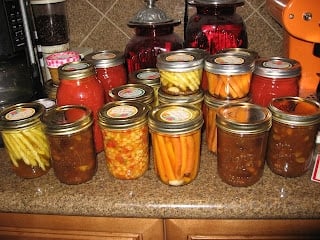I love Fall. It is my favorite season by far. I love the angle of the sun and how it casts such warming diffused light. I love the cool of the morning giving way to the lingering summer heat of the days. It feels to be both a culmination of all of summer’s labors in the harvest as well as a time to disposition food for winter.
Last year in my first seasonal attempt to be a Locavore I really felt more like a Loco Locavore. All who know me would politely share that I rarely do things halfway. When I take something on it is with a vengeance similar to a full immersion language course but in my case it’s more like being drop shipped into a foreign land and being left to my own devices subjecting friends and family to my exploits along the way.
Not knowing how to anticipate our winter needs I decided canning like a fiend, filling an auxiliary garage freezer, buying the top of the line dehydrator and creating my Urban Girl’s Wannabe root cellar would be the best way ensure we were able to adhere to our 100 mile self-imposed food radius (let’s be clear, MY self imposed radius; I had taken my family hostage). I ignored Whole Foods ‘it’s always summer somewhere’ produce availability. Gosh darn it I was going to summon all the Little-House-On-The-Prarie’ness I could muster and succeed at this challenge.
150 pounds of tomatoes later, a freezer packed for Armageddon, stacked milk crates full of root vegetables and a pantry full of dried goods I was ready for what the winter had in store.
Fast forward to the present, I learned a few things along the way….
First of all even if a family of four ate tomatoes several times a week, canning 150 pounds is probably excessive. This year I canned 1 25 pound box into tomato sauce and salsa to compliment the multiple quarts we did not eat yet.
Winter squash lasts forever….for the most part. We purchased an abundance of various winter squashes for the root cellar. It was so satisfying to trot down, burrow through the winter coats preceding the miniature door into the cave below the stairs to pluck something for dinner. Most of our squashes were still hard and flavorful with the first true signs spring had sprung (as much as we get those indicators in the Rockies where it’s usually more of a hop from late spring snow dumps to sweltering heat of summer). Occasionally we’d be surprised by reaching into a bin to find a gooey mess of a pumpkin that had succumbed but for the most part that was an exception.
Apples keep longer than you’d think. We’d gone apple picking at a local orchard and the proprietor assured us many varieties will last in a cool, dark place up to 5 months. I was sure she was high or perhaps launching a new marketing campaign designed to boost apple orchard sales. I stand corrected! We purchased two large boxes of Honey Crisp apples at one of our last Farmer’s Market in late October, housed them all in a small auxiliary refrigerator and could not believe when they were still juicy and fresh in the pit of our March winter. Some developed what we’d call ‘granny skin’ in that they appeared a bit more wrinkly than in their youth but once cut into they were firm and delicious.
Keeping with the theme of ‘full immersion’ I do own several canning recipe books. When coming across a new one I become twitchy imagining there might be that ONE recipe which differentiates the given book from the rest, perhaps housing a new family tradition to be passed down for generations (who’s willing to take that chance and not buy?!).
I’d like to share one tried-and-true recipe for Mexican Garden Salsa that we mowed through several pints of leaving me feeling perhaps I SHOULD have done one more box of tomatoes worth!
Mexican Garden Salsa
Recipe shared with the author’s permission from Blue Ribbon Preserves by Linda J. Amendt (2001)
Be sure to use plum tomatoes, such as Romas, to make this salsa. Salad-type tomatoes contain too much juice and will make a very thin, watery salsa. Wear rubber gloves when working with chile peppers to protect your skin from burns.
Makes about 12 half pints or 6 pint jars
12 cups cored and chopped plum tomatoes
3 cups chopped onions
3 cups seeded and cored Anaheim, Colorado or poblano chile peppers
1 3/4 cups seeded and chopped jalapeno chili peppers (about 40 small)
1/2 cup white wine vinegar
1/2 cup strained fresh lime juice
2 tablespoon kosher salt or pickling salt
In an 8 quart stainless steel pan, combine all of the ingredients.
Over medium-low heat, bring the mixture to a simmer and simmer gently for 10 minutes, stirring frequently to prevent sticking.
Ladle the salsa into hot jars, leaving 1/2 inch headspace. Using a plastic knife, remove any trapped air bubbles. If necessary, add more salsa to maintain 1/2 inch headspace. Wipe the jar rims and threads with a clean damp cloth. Cover with hot lids and apply screw rings. Process both half-pint and pint jars in a 212F (100C) water bath for 15 minutes. If at altitude additional processing time should be added (see chart).
NOTE: This recipe should only be attempted if you have knowledge of canning. I have not intended this to teach you how to can but merely supply a delicious recipe if you have canned before. The dangers of botulism are to be taken seriously!

Leave a Reply